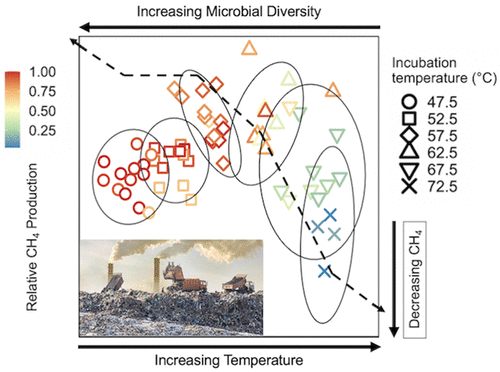当前位置:
X-MOL 学术
›
ACS ES&T Eng.
›
论文详情
Our official English website, www.x-mol.net, welcomes your
feedback! (Note: you will need to create a separate account there.)
Evaluation of the Temperature Range for Biological Activity in Landfills Experiencing Elevated Temperatures
ACS ES&T Engineering ( IF 7.4 ) Pub Date : 2020-10-01 , DOI: 10.1021/acsestengg.0c00064 Sierra Schupp 1 , Florentino B. De la Cruz 1 , Qiwen Cheng 1 , Douglas F. Call 1 , Morton A. Barlaz 1
ACS ES&T Engineering ( IF 7.4 ) Pub Date : 2020-10-01 , DOI: 10.1021/acsestengg.0c00064 Sierra Schupp 1 , Florentino B. De la Cruz 1 , Qiwen Cheng 1 , Douglas F. Call 1 , Morton A. Barlaz 1
Affiliation

|
There have been reports of municipal solid waste landfills with waste and gas wellhead temperatures of at least 80–100 °C, which is in excess of temperatures reported at typical landfills. Landfills experiencing heat accumulation over a broad area present a number of challenges involving leachate and gas quality and quantity, and the associated collection infrastructure. The objectives of this research were to evaluate the impact of temperature on methanogenesis and fermentation in landfills, and to evaluate the extent to which microbial populations acclimate when perturbed to either lower or higher temperatures relative to their in situ temperature. Samples excavated from two landfills exhibiting elevated temperatures were utilized as inocula for small- and reactor-scale experiments. The optimum temperature for methane generation in the thermophilic range was 47.5–57.5 °C, with yields reduced by ∼37 and 75% at 62.5 and 67.5 °C, respectively. While microbial populations did not acclimate above 67.5 °C, methanogenic activity resumed when waste was cooled. 16S rRNA sequencing revealed that Methanothermobacter likely plays a key role in facilitating methane production in landfills operating in the thermophilic range and that microbial community diversity decreased at higher incubation temperatures. There was evidence that fermentation occurs up to 77.5 °C, well above the upper limit for methanogens measured in this study. Model simulations predict that fermentation reactions contribute a ∼3–10 °C rise in waste temperature.
中文翻译:

高温下垃圾填埋场生物活性温度范围的估算
有报告称,城市固体废物填埋场的废物和天然气井口温度至少为80–100°C,超过了典型填埋场的温度。垃圾填埋场在大范围内积蓄热量,带来了许多挑战,涉及渗滤液和气体的质量和数量以及相关的收集基础设施。这项研究的目的是评估温度对垃圾填埋场甲烷生成和发酵的影响,并评估当微生物种群相对于原位温度处于较低或较高温度时其适应环境的程度。从表现出高温的两个垃圾填埋场挖出的样品用作小规模和反应堆规模实验的接种物。在嗜热范围内,甲烷生成的最佳温度为47.5-57.5°C,在62.5和67.5°C下,产率分别降低了约37和75%。尽管微生物种群无法适应67.5°C以上的温度,但是当废物冷却后,产甲烷活性得以恢复。16S rRNA测序表明甲烷甲烷杆菌可能在促进在高温范围内进行的垃圾填埋场中甲烷的产生中起关键作用,并且在较高的培养温度下微生物群落多样性降低。有证据表明,发酵在高达77.5°C的温度下进行,远高于本研究中测得的产甲烷菌的上限。模型模拟预测,发酵反应会使废物温度升高约3-10°C。
更新日期:2020-10-01
中文翻译:

高温下垃圾填埋场生物活性温度范围的估算
有报告称,城市固体废物填埋场的废物和天然气井口温度至少为80–100°C,超过了典型填埋场的温度。垃圾填埋场在大范围内积蓄热量,带来了许多挑战,涉及渗滤液和气体的质量和数量以及相关的收集基础设施。这项研究的目的是评估温度对垃圾填埋场甲烷生成和发酵的影响,并评估当微生物种群相对于原位温度处于较低或较高温度时其适应环境的程度。从表现出高温的两个垃圾填埋场挖出的样品用作小规模和反应堆规模实验的接种物。在嗜热范围内,甲烷生成的最佳温度为47.5-57.5°C,在62.5和67.5°C下,产率分别降低了约37和75%。尽管微生物种群无法适应67.5°C以上的温度,但是当废物冷却后,产甲烷活性得以恢复。16S rRNA测序表明甲烷甲烷杆菌可能在促进在高温范围内进行的垃圾填埋场中甲烷的产生中起关键作用,并且在较高的培养温度下微生物群落多样性降低。有证据表明,发酵在高达77.5°C的温度下进行,远高于本研究中测得的产甲烷菌的上限。模型模拟预测,发酵反应会使废物温度升高约3-10°C。











































 京公网安备 11010802027423号
京公网安备 11010802027423号